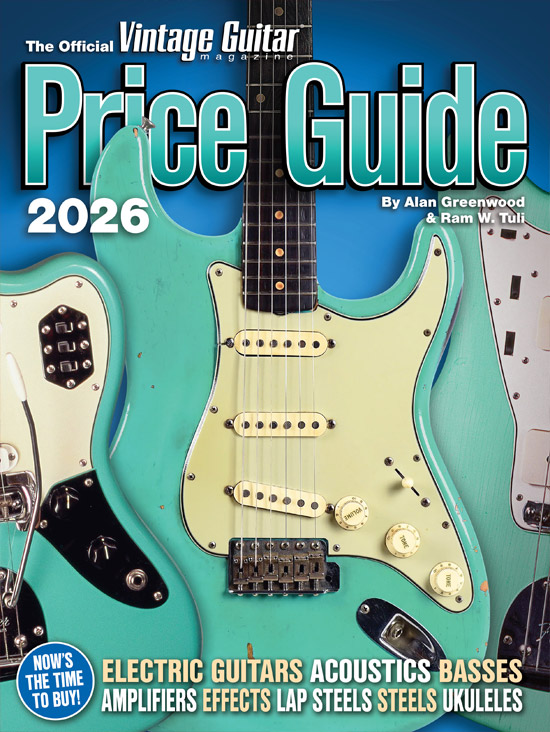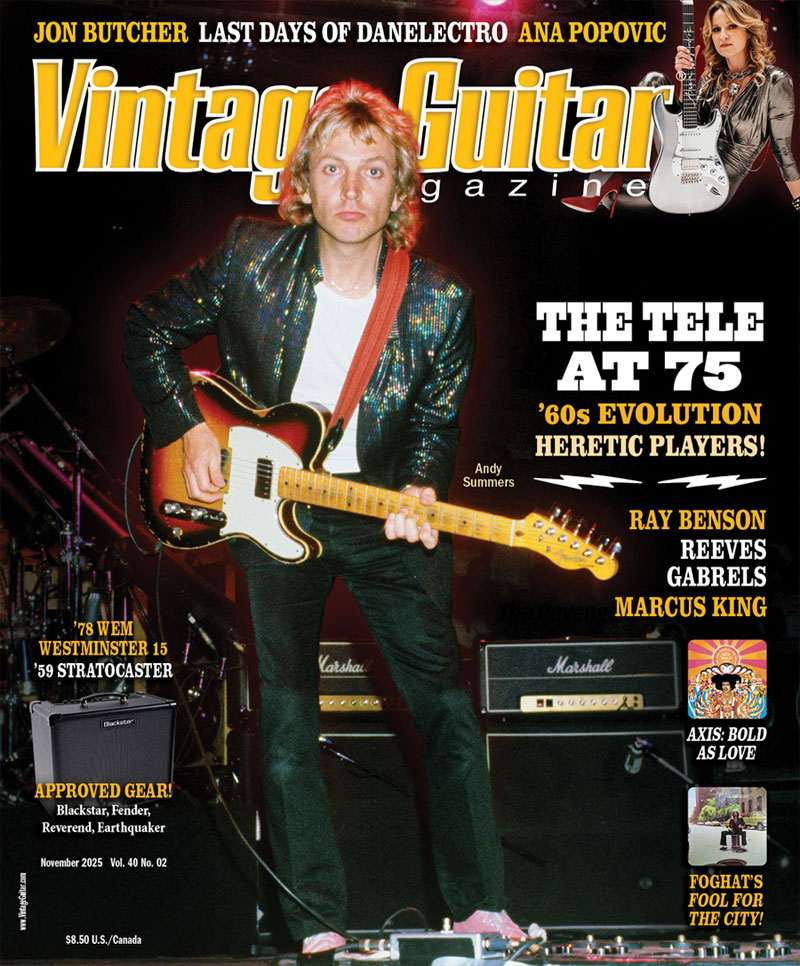
World War II was responsible for an unbelievable amount of what we today know as the modern world, from computers to plastics. Even though there was a previous similarly named conflagration, WWII was our only truly “world” war, where virtually no part of the globe went untouched. It was the aftermath of WWII that gave us “babyboomers,” the generation that created an incredible demand for guitars. And it was that very post-war effect that created the beginnings of the global economy, a part of which would supply America with its guitars, like the ’62 Hagstrom EDP46 DeLuxe shown here – a candidate for first electric guitar imported for the U.S. market.
Hagstrom was started in 1921 in Alvdalen, Sweden, when Albin Hagstrom (1905-’52) began importing accordions. His company began building its own accordions in late 1931 or early ’32 and in 1940 opened an office in New York with a view to exporting to the U.S. But WWII intervened. Accordions were becoming popular in America following the first World War, which was somewhat ironic given their association with Italian music. In Europe, the Italians were major manufacturers of accordions, but were not known for playing them.
 From 1945 until ’49, Hagstrom operated an accordion plant in Jamestown, New York, introducing the company to the American music industry. But it was following the brief accordion craze of the early 1950s that Scandinavian instrument manufacturers, including Hagstrom, became the first to see the coming opportunity of guitars. In ’58, Goya acoustic guitars made by the Swedish guitar manufacturer Levin and Espana acoustics made by the Finnish maker Landola began to be exported to meet the demands of the first babyboomers who were beginning to get caught up in the folk-music revival. That same year, Hagstrom also introduced its first guitars, the DeLuxe and the Standard.
From 1945 until ’49, Hagstrom operated an accordion plant in Jamestown, New York, introducing the company to the American music industry. But it was following the brief accordion craze of the early 1950s that Scandinavian instrument manufacturers, including Hagstrom, became the first to see the coming opportunity of guitars. In ’58, Goya acoustic guitars made by the Swedish guitar manufacturer Levin and Espana acoustics made by the Finnish maker Landola began to be exported to meet the demands of the first babyboomers who were beginning to get caught up in the folk-music revival. That same year, Hagstrom also introduced its first guitars, the DeLuxe and the Standard.
Technically speaking, the Hagstrom DeLuxe and Standard (the primary difference between the two was size; at 133/8″ versus 12″ the DeLuxe was wider) were acoustic/electrics in more ways than one! While often described as being “solidbodies,” they were actually thin hollowbodies with a supporting “sound post” inside, under the bridge. This alone makes them acoustic/electrics, but one of their many innovations included a series of modular, replaceable pickup housings that could be completely removed and replaced with a hole cover, turning these into “acoustic” guitars. They pretty much sucked as acoustics, but acoustics they had become.
Obviously inspired by the Gibson Les Paul in terms of shape, you couldn’t find a guitar more different. Besides the “hollow versus solid” element, the Hagstroms were made of thin hardwood and covered in plastic. Initially, DeLuxes came with flat tops covered in gold-, red-, or blue-sparkle plastic, while the backs and neck were covered in black plastic (the black-plastic facing seen here was a later option). The Standards were white pearloid with white backs. This use of plastic covering derived from Hagstrom’s background as an accordion maker.
Hagstrom necks were bolted on, but had a heel to feel similar to a set neck. The necks were reinforced with an “H-bar” of aircraft-grade aluminum that allowed them to be very thin, probably the thinnest made at the time. They weren’t adjustable, but they were guaranteed never to warp. The fingerboards consisted of a 1/4″ piece of Lucite into which the frets were set/glued over white paint. These fingerboards have an almost scalloped feel.
These first Hagstrom electrics came with four pickup module options. The best was the P46 seen here, with two sets of single-coil pickups on either side of a gold grill “swimming pool” that acted like humbuckers. Controls were a mix of pushbuttons (the first seen on a guitar) and three thumbwheels. The two top thumbwheels were a master Volume and Tone. Buttons were labeled SOLO, ACC, LH, L, H, and O. SOLO was a bypass switch which yielded maximum volume output. ACC threw the pickups to another roller switch under the pickups for accompaniment volume control. LH selected all pickups. L (low) selected the two neck pickups for a bass sound. H (high) selected the two bridge pickups. O turned the guitar off.
Other pickup modules included the P26, P24, and P12. The distinction between the first two is unclear, but both had two single-coil pickups and four pushbuttons, probably one with neck and bridge units and the other with a pair at the neck. The P12 had a single unit at the neck with two pushbuttons.
For most of their run, the Hagstrom DeLuxes featured their version of a tune-o-matic bridge, and a stop tail. In 1962, Hagstrom developed its vibrato, which had two springs in the back of the body (directly behind the screw next to the handle mount). These were put on subsequent Hagstrom electrics, including the DeLuxe seen here. Hagstrom distributed Guild guitars in Sweden, and that relationship helps explain why Guild solidbodies sported Hagstrom vibratos.
The Hagstrom Standards lasted until ’62, while the DeLuxes lasted into ’63. The Hagstrom DeLuxe is not a particularly rare bird, but neither is it plentiful. Only a little more than 2,000 were made over the course of their run. Most of these were probably the sparkle plastics, possibly making this black color fairly unusual. By ’62, Hagstrom had moved on to its better-known Stratocaster-shaped Kent models. Hagstrom continued to make electric guitars until 1983 and during the ’70s was about the only European manufacturer to experience continued success in the American market (with its Swede guitars), as guitar-making shifted to Japan, then Korea, and now just about everywhere.
Even though Hagstrom DeLuxes are not rare as hen’s teeth, they are really cool-looking – especially the sparkles – and jam-packed with innovations, particularly for the times. Plus they mark that moment when guitarmaking took its first steps toward becoming an international industry arising from the ruins of World War II.
This article originally appeared in VG‘s May 2009 issue. All copyrights are by the author and Vintage Guitar magazine. Unauthorized replication or use is strictly prohibited.



